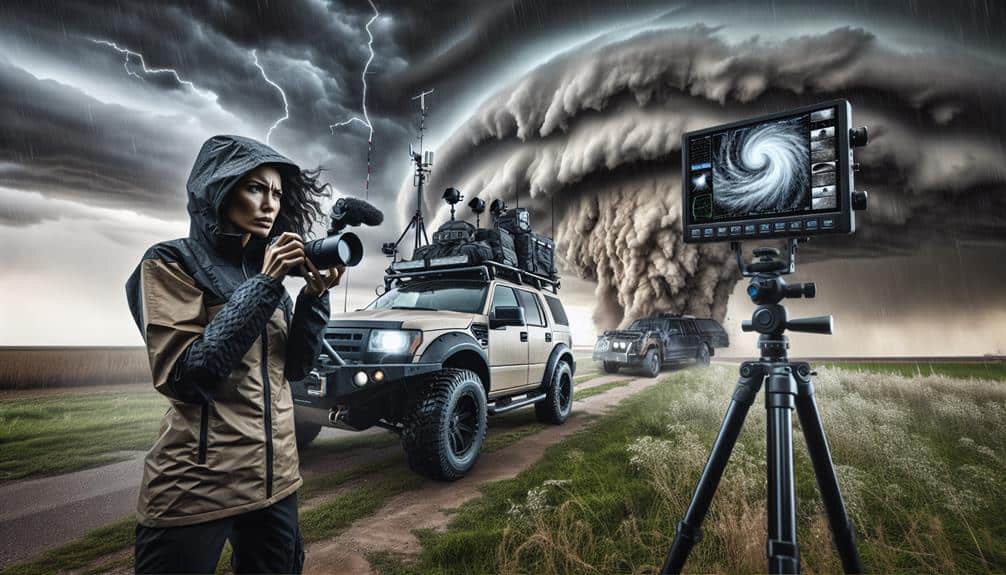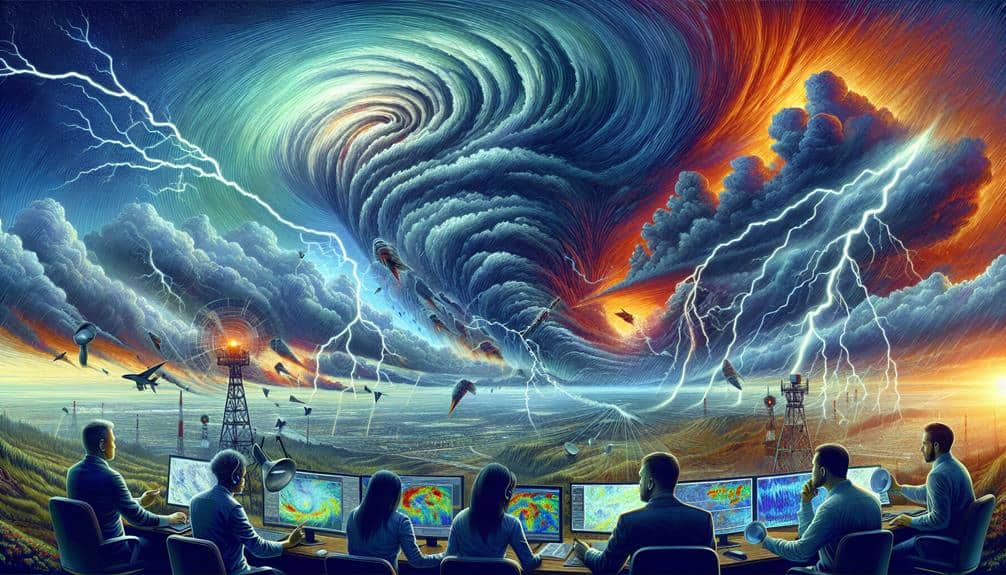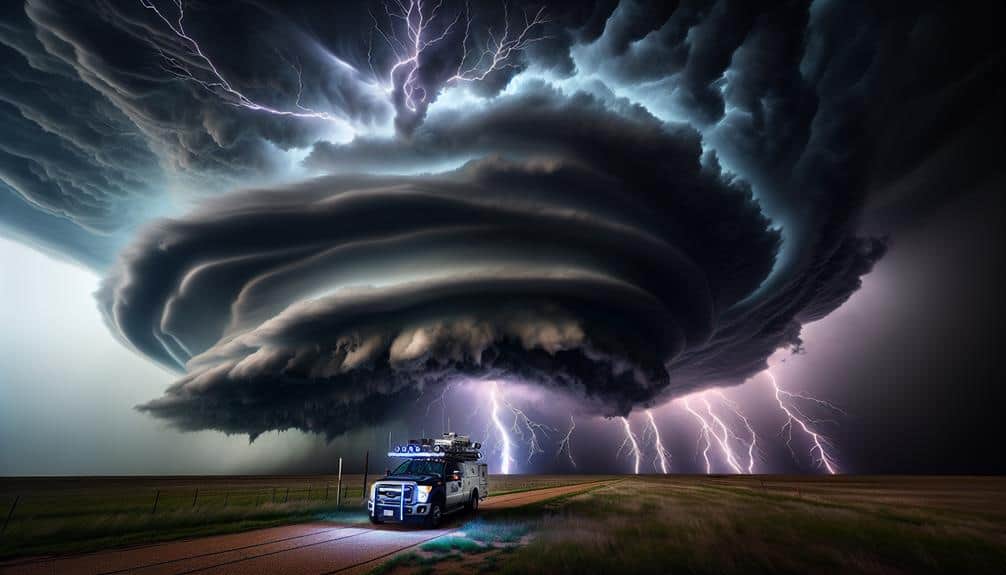Chasing supercell storms lets us analyze mesocyclones—deep, rotating updrafts indicating severe weather risks like tornadoes or large hail. We need reliable storm tracking devices, sturdy weather-proof gear, and communication tools to guarantee safety and effective data capturing. It's important to develop emergency protocols, stock essential supplies, and monitor real-time weather updates. For dynamic photography, manual camera settings and strategic positioning are key. By joining the storm chasing community, we gain valuable insights from seasoned chasers, adhere to safety practices, and enhance our storm tracking skills. Continue exploring to understand all facets of storm chasing.
Key Points
- Supercell storms offer unique opportunities to observe and study severe weather phenomena like tornadoes and large hail up close.
- Chasing supercell storms allows for the collection of valuable meteorological data to enhance weather prediction models.
- Storm chasing provides exhilarating experiences and the chance to capture stunning, dynamic weather photography.
- By observing supercells, storm chasers contribute to scientific research and public safety awareness regarding severe weather.
Understanding Supercell Storms
Supercell storms, the most severe type of thunderstorm, are characterized by their deep, rotating updrafts known as mesocyclones. To understand these complex systems, we need to explore their storm formation and storm structure.
Supercells form when there's significant wind shear and instability in the atmosphere. Warm, moist air near the surface rises and encounters cooler, drier air aloft, initiating convection.
We observe that the key feature of a supercell's storm structure is the mesocyclone, which results from the tilting of horizontal vorticity into the vertical by the storm's updraft. This rotating column of air is what sets supercells apart from other thunderstorms.
The mesocyclone's presence indicates the potential for severe weather, including tornadoes, large hail, and damaging winds.
Essential Gear for Storm Chasing
When we embark on a storm chasing journey, having the right gear is crucial for safety and effective data collection. Without the appropriate equipment, our storm preparation can fall short, compromising both our safety and the quality of our observations. Let's delve into the gear essentials for a successful chase.
1. Storm Tracking Devices
Reliable storm tracking devices are non-negotiable. We need high-resolution radar apps and GPS units to monitor storm movements accurately. These tools help us anticipate storm paths and identify potential hazards.
Effective communication devices are critical. Two-way radios and mobile phones guarantee we stay connected with our team and emergency services. In areas with poor cellular coverage, satellite phones offer an extra layer of security.
3. Weather-Proof Equipment
We must shield our gear from the elements. Sturdy, weather-proof cases for cameras and laptops keep our tools functional even in harsh conditions. Backup batteries and power banks are also crucial to maintain continuous operation.
Safety Tips and Best Practices
Armed with the right gear, we must now focus on implementing safety tips and best practices to ensure a secure and productive storm chasing experience. First, developing robust emergency protocols is crucial. Always have a detailed plan in place, including multiple exit routes and a designated meeting point in case we get separated. It's vital to keep a first aid kit, extra fuel, and non-perishable food items in our vehicle.
Communication devices, such as two-way radios or satellite phones, are necessary to ensure we stay connected even when cell service is unavailable.
Weather awareness is another vital component. Regularly monitor weather updates from reliable sources like the National Weather Service (NWS) and utilize weather apps tailored for storm chasers. These tools provide real-time data on storm trajectories, wind speeds, and potential hazards. Staying informed about the storm's development allows us to make timely decisions and avoid dangerous situations.
Additionally, maintain a safe distance from the storm. Positioning ourselves at least a few miles away from the supercell's core minimizes risks from hail, lightning, and sudden tornado formation.
Capturing the Perfect Shot
Often, capturing the ideal shot requires a precise understanding of camera settings, best positioning, and the storm's dynamic behavior. We need to master composition techniques and lighting conditions to truly capture the essence of a supercell storm.
The following steps will help us achieve that perfect shot:
- Manual Camera Settings: It's essential to switch our cameras to manual mode. Adjusting the aperture, ISO, and shutter speed allows us to control exposure and capture the storm's intensity and detail. Typically, a low ISO setting (100-400) and a narrow aperture (f/8-f/16) work best for storm photography.
- Optimal Positioning: Our location relative to the storm is crucial. Positioning ourselves on the storm's southeastern flank usually offers the best views. This side often has clearer skies and better lighting conditions, creating a dramatic contrast against the storm's dark, swirling clouds.
- Understanding Storm Behavior: We must study the storm's movement and evolution. Tools like radar apps and meteorological data help predict the storm's path and changes, enabling us to anticipate the best moments for capturing dynamic shots.
Joining the Storm Chasing Community

Connecting with the storm chasing community provides invaluable insights and real-time information that enhance our storm photography skills and safety. By building community, we gain access to experienced chasers who can offer guidance on weather patterns, equipment, and strategic positioning. Collaborating with others ensures we adhere to storm chasing etiquette, fostering respect and safety on the field.
We can join online forums, social media groups, and local meteorological societies to connect with fellow enthusiasts. These platforms often feature data-driven discussions, live updates, and expert analyses, which are essential for making informed decisions during a chase. Additionally, many communities organize meetups and workshops where we can learn about the latest storm tracking technologies and methodologies.
Understanding storm chasing etiquette is crucial. This includes respecting private property, maintaining a safe distance from the storm, and not obstructing emergency vehicles. By following these guidelines, we contribute to a safer and more respectful environment for everyone involved.
In essence, joining the storm chasing community not only enriches our knowledge but also creates a network of support. This network is pivotal in maximizing our freedom to explore while minimizing risks. The collective wisdom and shared passion make storm chasing a more rewarding and safer experience.
Frequently Asked Questions
How Do I Predict When and Where Supercells Will Form?
To predict supercells, we analyze storm formation research, weather patterns, and atmospheric conditions. By studying radar data, wind shear, and moisture levels, we can pinpoint when and where these powerful storms are likely to form.
What Are the Best Online Resources for Real-Time Storm Tracking?
We rely on storm chaser communities and advanced weather radar technology for real-time storm tracking. Websites like Stormtrack and RadarScope provide accurate, up-to-the-minute data, empowering us to make informed decisions and chase safely.
Can Storm Chasing Be a Viable Career Option?
Can storm chasing be a viable career option? Yes, with niche career prospects, storm chasing offers financial stability through media contracts and research grants. However, it requires substantial expertise and can be inconsistent compared to traditional careers.
How Do I Get Permission to Enter Restricted Areas During a Chase?
Remember the thrill of seeking new frontiers? To enter restricted areas during a chase, we need necessary permits and must follow safety protocols. Acquiring these guarantees our freedom to explore while prioritizing everyone's safety.
What Legal Considerations Should I Be Aware of While Storm Chasing?
When storm chasing, we must consider liability concerns and insurance requirements. Having proper coverage protects us from potential damages or injuries. Stay informed about local regulations and make sure our actions don't infringe on others' rights or property.


